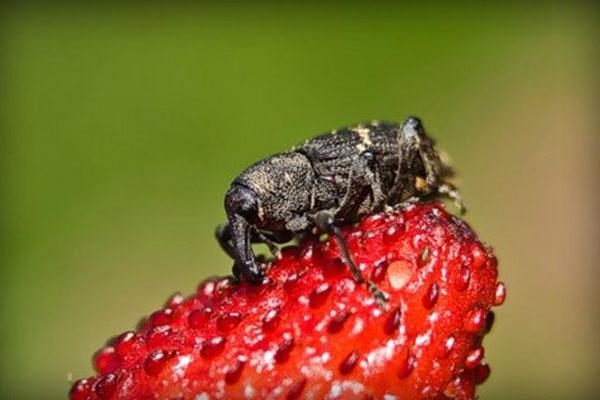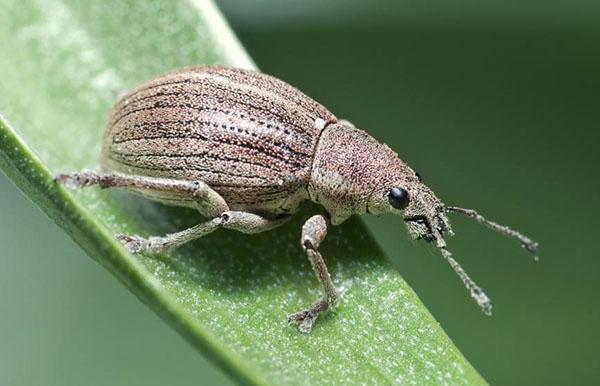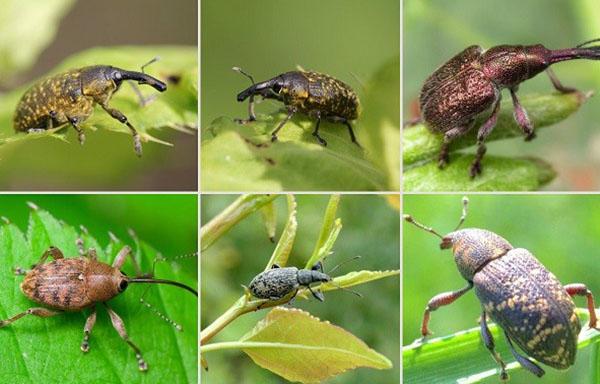Fighting the weevil with folk remedies and chemicals
 A huge number of pests settle in our gardens and vegetable gardens, which eat up the vegetative mass of plants, damage fruits and seeds. Fighting the weevil requires a special approach, because this parasite multiplies quickly, causing significant harm to vegetables and grain crops.
A huge number of pests settle in our gardens and vegetable gardens, which eat up the vegetative mass of plants, damage fruits and seeds. Fighting the weevil requires a special approach, because this parasite multiplies quickly, causing significant harm to vegetables and grain crops.
Description of the pest

The family can be roughly divided into two large subgroups:
- Insects with a long proboscis that can reach the size of the body. The pest uses this organ to pierce soft tissues. In most cases, weevil larvae develop in the leaves of garden or horticultural crops.
- Beetles with short proboscis feed not only on plant juices, but also gnaw the shells of grain. The larvae of these parasites develop in the upper soil layer.
During the life cycle of beetles, elephants lay a huge number of larvae. To fight weevils more efficiently, you need to know what these individuals look like. Insect larvae are usually small with a white body and white head, similar to a caterpillar, but have no legs, powerful jaws are present in the front part. Depending on the species, these individuals feed on sap or plant roots.
Popular types
 As you can understand, the insects in question feed on all vegetative parts of garden crops, from roots to inflorescences. Landings are harmed not only by adult beetles, but also by their larvae. Insects multiply quickly, even a small number of them can lead to the death of the apple crop, raspberries or strawberries.
As you can understand, the insects in question feed on all vegetative parts of garden crops, from roots to inflorescences. Landings are harmed not only by adult beetles, but also by their larvae. Insects multiply quickly, even a small number of them can lead to the death of the apple crop, raspberries or strawberries.
If a pest enters the barn, the owner can lose a significant part of the grain reserves. To know how to effectively deal with a weevil, it is necessary to learn to distinguish between these beetles by their appearance.
Let's describe the most popular types:
- Barn. This beetle with a body length of up to 4 millimeters has a dark brown color, settles in a grain storage and destroys stocks (peas, buckwheat, corn, cereals). After that, the planting material cannot germinate.
- The striped nodule weevil feeds on peas, beans, soybeans and other legumes; the female can lay about 3000 eggs per season. Adult beetles eat up vegetative parts of crops, larvae damage the root part of plants. Control measures include treating crops with special chemicals with insecticides or digging up the soil in the fall, several weeks before the first frost. Such soil treatment allows you to destroy the larvae of the parasite.
- Gray weevils damage the buds of fruit crops in the garden; adult beetles and larvae feed on plant buds. The length of the parasite is no more than 6 millimeters, the color of the body is silvery with a brown tint. The larvae develop in the soil, damage the root system of trees and other plants. One of the most effective measures to combat the gray bud weevil is the digging of soil in the near-trunk circle of trees, as well as the destruction of organic remains.
- The gray beet beetle weevil can dilute or completely destroy beet crops.In addition to this cult, the parasite feeds on sunflower and corn seedlings. The life span of insects is about 2 years. The body length of the beetle is up to 1.2 millimeters. It is quite difficult to determine the presence of the parasite on the site due to their size and covering color. The main measure to combat the beet weevil is the spraying of plantings with insecticides.
In addition to these parasites, it is worth paying attention to the potato weevil. These beetles overwinter in the soil, but feed on the aboveground part of the culture in question.
Fighting weevil folk remedies
 Not every gardener will use chemicals to kill pests. Weevil control methods begin with the use of folk remedies.
Not every gardener will use chemicals to kill pests. Weevil control methods begin with the use of folk remedies.
During the period of bud formation, plants can be sprayed with the following working solutions:
- 10-15 grams of mustard powder per 10 liters of water with the addition of pav (20-25 milliliters of liquid soap).
- 2-3 kilograms of wood ash per bucket of liquid. The solution is insisted for several hours and filtered, liquid soap is added.
Treatment of the garden from the weevil should be started in early spring along the bare branches, then along the buds, in the period before the flowering of crops and after the formation of the ovary.
Spraying trees and other plants is recommended to be carried out in the evening hours in calm weather.
Chemicals
 Traditional methods of control do not always help to get rid of pests, and especially when they have settled on the site in large numbers. If the available remedies for the weevil did not give the desired effect, you will have to buy special chemicals that are designed to destroy the entire population of parasites. It is recommended to use such compositions in early spring, as well as in the period before and after flowering crops. The last processing of garden and garden plants should be carried out no later than one month before the expected time of harvest.
Traditional methods of control do not always help to get rid of pests, and especially when they have settled on the site in large numbers. If the available remedies for the weevil did not give the desired effect, you will have to buy special chemicals that are designed to destroy the entire population of parasites. It is recommended to use such compositions in early spring, as well as in the period before and after flowering crops. The last processing of garden and garden plants should be carried out no later than one month before the expected time of harvest.
The most popular chemicals for weevil control are:
- The drug "Kinmix" at the rate of 2.5 milliliters of active substance per bucket of water.
- The drug "Decis" at the rate of 2 milliliters for the same volume of liquid.
- Chemicals "Karbofos-500", "Iskra-M" or "Fufanon" are used throughout the entire growing season of plants. For spraying crops, a working solution is prepared, 10 milliliters of one of the funds per bucket of water.
A good effect in the fight against pests can be achieved when using "Fozalon", "Diazonin" or "Bazudin". These substances are diluted with water according to the manufacturer's instructions. They are used not only for spraying the vegetative part of crops, but also for soil cultivation.
Be careful when treating plants with chemicals, use personal protective equipment.
Weevil control measures - video